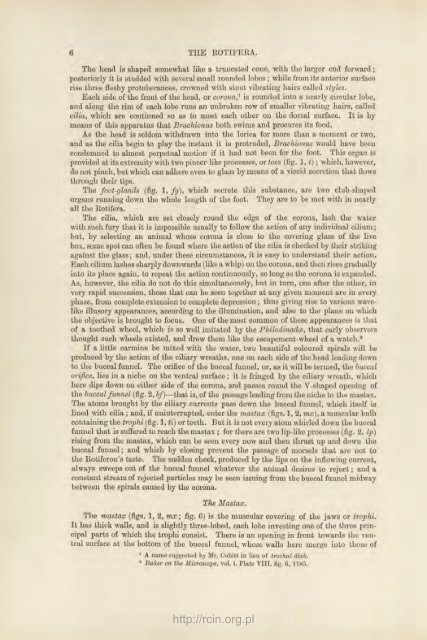Create successful ePaper yourself
Turn your PDF publications into a flip-book with our unique Google optimized e-Paper software.
Tlie head is shaped somewhat like a truncated cone, with <strong>the</strong> larger end forward;<br />
posteriorly it is studded with several small rounded lobes ; while from its anterior surface<br />
rise three fleshy protuberances, crowned with stout vibrating hairs called styles.<br />
Each side of <strong>the</strong> front of <strong>the</strong> head, or coronais rounded into a nearly circular lobe,<br />
and along <strong>the</strong> rim of each lobe runs an unbroken row of smaller vibrating hairs, called<br />
cilia, which are continued so as to meet each o<strong>the</strong>r on <strong>the</strong> dorsal surface. It is by<br />
means of this apparatus that Brachionus both swims and procures its food.<br />
As <strong>the</strong> head is seldom withdrawn into <strong>the</strong> lorica for more than a moment or two,<br />
and as <strong>the</strong> cilia begin to play <strong>the</strong> instant it is protruded, Brachionus would have been<br />
condemned to almost perpetual motion if it had not been for <strong>the</strong> foot. This organ is<br />
provided at its extremity with two pincer-like processes, or toes (fig. 1, t); which, however,<br />
do not pinch, but which can adhere even to glass by means of a viscid secretion that flows<br />
through <strong>the</strong>ir tips.<br />
The foot-glands (fig. 1, fg), which secrete this substance, are two club-shaped<br />
organs running down <strong>the</strong> whole length of <strong>the</strong> foot. They are to be met with in nearly<br />
all <strong>the</strong> Eotifera.<br />
The cilia, which are set closely round <strong>the</strong> edge of <strong>the</strong> corona, lash <strong>the</strong> water<br />
with such fury that it is impossible usually to follow <strong>the</strong> action of any individual cilium;<br />
but, by selecting an animal whose corona is close to <strong>the</strong> covering glass of <strong>the</strong> live<br />
box, some spot can often be found where <strong>the</strong> action of <strong>the</strong> cilia is checked by <strong>the</strong>ir striking<br />
against <strong>the</strong> glass; and, under <strong>the</strong>se circumstances, it is easy to understand <strong>the</strong>ir action.<br />
Each cilium lashes sharply downwards (like a whip) on <strong>the</strong> corona, and <strong>the</strong>n rises gradually<br />
into its place again, to repeat <strong>the</strong> action continuously, so long as <strong>the</strong> corona is expanded.<br />
As, however, <strong>the</strong> cilia do not do this simultaneously, but in turn, one after <strong>the</strong> o<strong>the</strong>r, in<br />
very rapid succession, those that can be seen toge<strong>the</strong>r at any given moment are in every<br />
phase, from complete extension to complete depression; thus giving rise to various wavelike<br />
illusory appearances, according to <strong>the</strong> illumination, and also to <strong>the</strong> plane on which<br />
<strong>the</strong> objective is brought to focus. One of <strong>the</strong> most common of <strong>the</strong>se appearances is that<br />
of a too<strong>the</strong>d wheel, which is so well imitated by <strong>the</strong> Philodinadce, that early observers<br />
thought such wheels existed, and drew <strong>the</strong>m like <strong>the</strong> escapement-wheel of a watch. 2<br />
If a little carmine be mixed with <strong>the</strong> water, two beautiful coloured spirals will be<br />
produced by <strong>the</strong> action of <strong>the</strong> ciliary wreaths, one on each side of <strong>the</strong> head leading down<br />
to <strong>the</strong> buccal funnel. The orifice of <strong>the</strong> buccal funnel, or, as it will be termed, <strong>the</strong> buccal<br />
orifice, lies in a niche on <strong>the</strong> ventral surface; it is fringed by <strong>the</strong> ciliary wreath, which<br />
here dips down on ei<strong>the</strong>r side of <strong>the</strong> corona, and passes round <strong>the</strong> V-shaped opening of<br />
<strong>the</strong> buccal funnel (fig. 2, bf)—that is, of <strong>the</strong> passage leading from <strong>the</strong> niche to <strong>the</strong> mastax.<br />
The atoms brought by <strong>the</strong> ciliary currents pass down <strong>the</strong> buccal funnel, which itself is<br />
lined with cilia ; and, if uninterrupted, enter <strong>the</strong> mastax (figs. 1, 2, mx), a muscular bulb<br />
containing <strong>the</strong> trophi (fig. 1, ti) or teeth. But it is not every atom whirled down <strong>the</strong> buccal<br />
funnel that is suffered to reach <strong>the</strong> mastax ; for <strong>the</strong>re are two lip-like processes (fig. 2, Ip)<br />
rising from <strong>the</strong> mastax, which can be seen every now and <strong>the</strong>n thrust up and down <strong>the</strong><br />
buccal funnel; and which by closing prevent <strong>the</strong> passage of morsels that are not to<br />
<strong>the</strong> Rotiferon's taste. The sudden check, produced by <strong>the</strong> lips on <strong>the</strong> inflowing current,<br />
always sweeps out of <strong>the</strong> buccal funnel whatever <strong>the</strong> animal desires to reject; and a<br />
constant stream of rejected particles may be seen issuing from <strong>the</strong> buccal funnel midway<br />
between <strong>the</strong> spirals caused by <strong>the</strong> corona.<br />
The<br />
Mastax.<br />
The mastax (figs. 1, 2, mx\ fig. 6) is <strong>the</strong> muscular covering of <strong>the</strong> jaws or trophi.<br />
It has thick walls, and is slightly three-lobed, each lobe investing one of <strong>the</strong> three principal<br />
parts of which <strong>the</strong> trophi consist. There is an opening in front towards <strong>the</strong> ventral<br />
surface at <strong>the</strong> bottom of <strong>the</strong> buccal funnel, whose walls here merge into those of<br />
1 A name suggested by Mr. Cubitt in lieu of trochal disk.<br />
2 Baker on <strong>the</strong> Microscope, vol. i. Plate VIII. fig. 6, 1785.<br />
http://rcin.org.pl
















